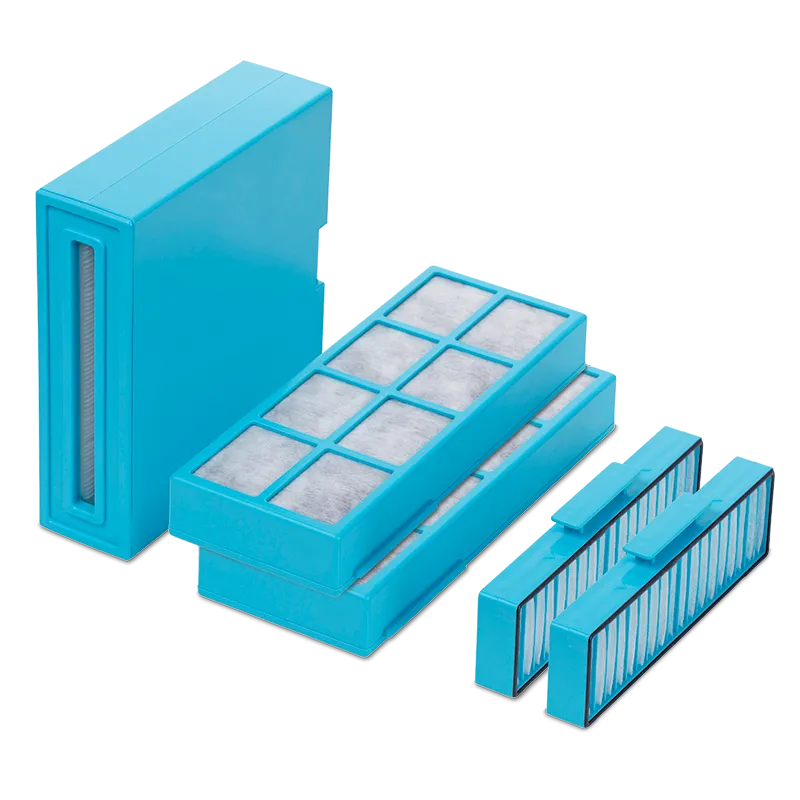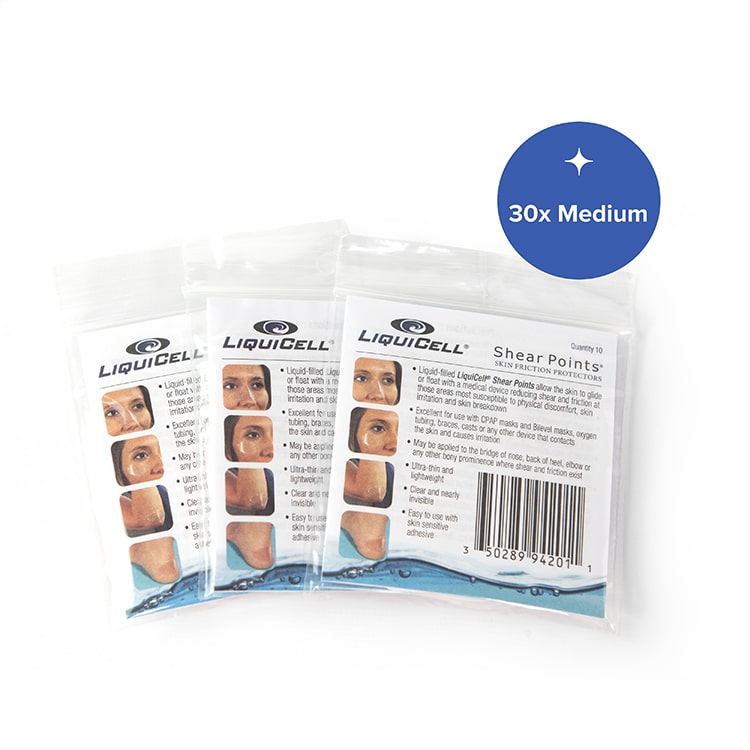Air Filtering
The air on Earth is a mixture of gases, suspended solids, and biological forms. The gas mixture is primarily nitrogen and oxygen. A very small portion of the gases are argon, an unreactive gas. An even smaller portion is carbon dioxide, a by-product of biological organisms and human activities.
The suspended solids include soot, soil, pollen, mold, bacteria, viruses, and various other materials that can be harmful. A variety of methods have been developed to make the air easier to breathe by filtering out the suspended solids. Air filtering aims to remove solid contaminants in the air.
SoClean 3-Stage Air Purifier+
How air filters work
Air filtering is a simple and straightforward process. Air is forced through a mat of fibers which are packed tightly enough to trap miniscule particles, but not so tightly that air cannot pass. Particulate matter that collides with a fiber will stick to the fiber, meaning that when the air comes out of the other side of the filter, any particles that collided with a fiber will be left behind.
This air cleaning system can be incredibly effective. HEPA filters remove at least 99.97% of particulate matter that is 0.3 microns in diameter. For particles larger or smaller than 0.3 microns, HEPA filters remove more than 99.97% of the particles. That means for every 3,000 particles that enter a HEPA filter, less than one makes it through.
One drawback of fiber filtering is the need to change the filter periodically. This can prove expensive over time, and if there are no spare filters on hand the risk of running an air filter with a dirty filter is increased. Also, if there is sufficient moisture in the system, mold and bacteria can grow in the filter medium, posing potential health risks until the filter is swapped out.
Electrostatic filters dispense with the need to replace physical filters by imparting an electric charge to incoming air. The particles in the air are then attracted to an oppositely charged plate, or to the surrounding environment. The plates can be cleaned and reused, meaning that the problem of replacing a filter is avoided.
The fibrous and electrostatic filters take care of solid pollutants, but as far as removing volatile organic compounds goes, other steps are required. Activated carbon is specially processed carbon, often charcoal, that has a very large surface area. Volatile organic compounds readily adhere to the surface of the activated carbon. This process, called adsorption, differs from absorption in that the molecules only stick to the surface of the solid carbon instead of absorbing into the body. Air purifiers with carbon filters include an activated carbon layer that captures gaseous and suspended liquid pollutants from the air.
SoClean 3-Stage Air Purifier+
Shop NowOther considerations
Air filters can only filter the air that passes through them. This is why it is recommended to place multiple air filters throughout a home. An alternative arrangement for air filtering an entire home is to place the filter within the HVAC system. The air filter can be placed between the intake of outdoor air and the rest of the system, and can also be placed in a recirculation line to help filter already conditioned air.
In the close quarters of a hospital ward, an infection can quickly move from patient to patient. Transmission of airborne diseases between patients in hospitals can be reduced by ensuring that air delivered to different rooms has been through an air filtration system.1
More Products from SoClean
SoClean Air Purifier+ Filter Kit
$149
Portable Outlet CPAP Backup Battery V2
Save $50!
New and improved model - when the power goes out, your CPAP stays on!
Just plug the new Portable Outlet UPS between your CPAP equipment and your bedside wall socket to protect from loss of power due to storms or outages.
$349
LiquiCell Shear Points, 30 Skin Friction Protectors, Medium
Great for use anywhere skin would benefit from cushioning and protection. Ultra-thin, liquid-filled strips protect skin and stay in place.
FSA/HSA eligible LiquiCell Shear Points are latex-free, ultrathin, clear liquid-filled membranes that provide a synthetic, external cushion. It reduces painful friction by allowing an object to glide or float over the skin. Gentle skin adhesive keeps LiquiCell Shear Points securely in place overnight, while allowing easy and painless removal in the morning.
Medium, 30 per box, each 2.75" wide by 1.3" high
Also available: Small (30 per box, each 2.2" wide by 1.1" high) LiquiCell Shear Points are excellent for use on the bridge of the nose to reduce irritation from sleep equipment such as face masks.
$19.95
FAQs
Fiber-based air filtration systems are designed to work as efficiently as possible; however, there is a restriction in airflow as air passes through the filter medium. The HEPA filter standard puts limits on how much a HEPA filter can restrict air. Electrostatic filters, which use an electric charge to cause particles to adhere to charged metal plates, cause a much lower drop in air pressure than fibrous media filters.
That’s all the stuff that was in the air and could have ended up in your lungs! Air filtering works best with a clean filter, so make sure to replace or clean the filter regularly, according to the manufacturer's guidelines. When the filter gets dirty, optimal airflow is restricted. This leads to a slowdown in the amount of air that can make it through, and less air can be processed.
Price alone doesn’t determine how well an air filter works. Look for independent research or testing for a given model before purchasing an air filter, air purifier or air cleaner.
Air filters designed to the HEPA standard are very effective at reducing the number of airborne particles. The HEPA designation requires that at least 99.97% of particulate matter that is 0.3 microns in diameter (PM0.3) be removed by the filter. Significantly, HEPA filters are more effective at removing particulate matter that is larger or smaller than this size. This means that for particles smaller and larger than 0.3 microns in diameter, HEPA filters remove more than 99.97% of the particulate matter.
Air filters can only filter the air that manages to pass through the filter. As particles start to accumulate on the filter, air flow is reduced, meaning that less air is processed. This makes the air filtering less effective.
More Products from SoClean
SoClean 3
SoClean 3 is Sold Out. Be among the first to experience the new FDA-Cleared SoClean 3+, featuring best-in-class engineering and cutting-edge technology.
$398
Portable Outlet CPAP Backup Battery V2
Save $50!
New and improved model - when the power goes out, your CPAP stays on!
Just plug the new Portable Outlet UPS between your CPAP equipment and your bedside wall socket to protect from loss of power due to storms or outages.
$349
LiquiCell Shear Points, 30 Skin Friction Protectors, Medium
Great for use anywhere skin would benefit from cushioning and protection. Ultra-thin, liquid-filled strips protect skin and stay in place.
FSA/HSA eligible LiquiCell Shear Points are latex-free, ultrathin, clear liquid-filled membranes that provide a synthetic, external cushion. It reduces painful friction by allowing an object to glide or float over the skin. Gentle skin adhesive keeps LiquiCell Shear Points securely in place overnight, while allowing easy and painless removal in the morning.
Medium, 30 per box, each 2.75" wide by 1.3" high
Also available: Small (30 per box, each 2.2" wide by 1.1" high) LiquiCell Shear Points are excellent for use on the bridge of the nose to reduce irritation from sleep equipment such as face masks.
$19.95
Why SoClean
Keep your home fresh and SoClean with the SoClean 3-Stage Air Purifier+. Up to 3,000 times more efficient than HEPA standards, the SoClean 3-Stage Air Purifier+ captures particles down to 10 nanometers and generates cleanroom-level clean air for your home. The easy-to-use design makes it simple to produce quality air wherever you are.
Master Air Purifier Sources:
Air quality sources:
https://pubs.acs.org/doi/abs/10.1021/acs.est.5b01236
https://www.smu.edu.sg/sites/default/files/economics/shea2014/presentation/pollution_talk_april_2014_ham2.pdf
https://www.airnow.gov/aqi/aqi-basics/
https://www.ncbi.nlm.nih.gov/pmc/articles/PMC4484965/
https://www.sciencedirect.com/science/article/abs/pii/S0048969701007653
https://www.cfp.ca/content/57/8/881/tab-figures-datad1
https://ehp.niehs.nih.gov/doi/full/10.1289/ehp.1002255
https://www.gotopac.com/art-cr-iso-cleanroom-classifications
https://www.researchgate.net/publication/316472615_A_review_of_air_filtration_technologies_for_sustainable_and_healthy_building_ventilation
https://www.epa.gov/indoor-air-quality-iaq
https://www.airnow.gov/sites/default/files/2020-05/aqi-technical-assistance-document-sept2018.pdf
https://www.health.ny.gov/environmental/indoors/air/pmq_a.htm#:~:text=Exposure%20to%20fine%20particles%20can,as%20asthma%20and%20heart%20disease
Air purification/filtration process sources:
https://www.consumerreports.org/cro/air-purifiers/buying-guide/index.htm
https://www.epa.gov/sites/production/files/2018-07/documents/residential_air_cleaners_-_a_technical_summary_3rd_edition.pdf
https://www.ncbi.nlm.nih.gov/pmc/articles/PMC6272289/
https://link.springer.com/article/10.1007%2Fs100220100046
https://www.kompareit.com/homeandgarden/hvac-compare-central-air-cleaner-cost.html
https://www.chemviron.eu/products/activated-carbon/
https://www.who.int/occupational_health/publications/en/oehairbornedust3.pdf
https://academic.oup.com/jimb/article/32/7/319/5992784?login=true
https://www.cabotcorp.com/solutions/products-plus/activated-carbon
https://www.sciencedirect.com/science/article/abs/pii/S009167499970391X
https://www.tandfonline.com/doi/full/10.3109/02770903.2014.895011
https://www.ashrae.org/file%20library/about/position%20documents/filtration-and-air-cleaning-pd.pdf
HEPA, UPLA, and MERV filter sources:
https://pubmed.ncbi.nlm.nih.gov/16517004/
https://www.britannica.com/science/human-respiratory-system/The-mechanics-of-breathing
https://www.epa.gov/pm-pollution/particulate-matter-pm-basics
https://www.merriam-webster.com/dictionary/HEPA
https://www.standards.doe.gov/standards-documents/3000/3020-astd-2015
https://www.standards.doe.gov/standards-documents/3000/3020-astd-2015/@@images/file
https://www.sciencedirect.com/science/article/abs/pii/S0195670105005074
https://www.ncbi.nlm.nih.gov/pmc/articles/PMC1477932/
https://pediatrics.aappublications.org/content/127/1/93.short
https://www.tandfonline.com/doi/full/10.1080/02786820500191348
https://www.sciencedirect.com/science/article/abs/pii/0360128583900023
https://onlinelibrary.wiley.com/doi/abs/10.1002/ajim.4700270302
https://www.laboratory-supply.net/blog/difference-between-a-hepa-and-ulpa-filter/
https://www.sciencedirect.com/science/article/abs/pii/S0360132320305588
https://www.karger.com/Article/Abstract/151502
https://www.grainger.com/know-how/equipment-information/kh-what-is-merv-rating-air-filter-rating-chart
https://www3.epa.gov/ttn/catc/dir1/ff-hepa.pdf
https://www.epa.gov/indoor-air-quality-iaq/what-merv-rating-1
Sources:











